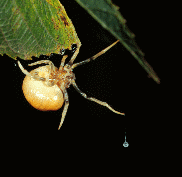
University of Kentucky Department of Entomology







BOLAS SPIDERSby Rudy Scheibner,
|
 | Bolas spiders are relatively rare members of the large family known as orb weavers. Instead of using a typical web to capture prey, nearly mature and mature female bolas spiders swing a droplet of adhesive on a thread at flying insects. |
Mastophora hutchinsoni is one of five Mastophora species known from the United States and occurs over much of North America. It has only one generation per year in Kentucky and overwinters in the egg stage. Spiderlings emerge in May. Males, which are much smaller than females, mature in late June and early July; and females mature in early September. Eggs are produced from late September to late October or early November. Newly emerged spiderlings do not use a bolas, but instead hunt by placing themselves on the underside of leaf margins where they ambush small prey that crawl along the leaf margin. Mature and nearly mature female M. hutchinsoni use a bolas to capture moths.
Only male moths were captured, specifically three species of Noctuidae (bristly cutworm, bronzed cutworm and smoky tetanolita) and one species of Pyralidae (bluegrass sod webworm). Among 492 prey captured by more than 20 spiders at two sites during 1985 and 1986, smoky tetanolita moth and bristly cutworm moths accounted for 93% of the total. The flight behavior of approaching moths, the limited kinds of moths caught from a large population of other kinds of available moths, and the fact that only males were caught support the hypothesis that the spider attracts its prey by producing chemicals that mimic the sex pheromone of these moth species. A spider often captured more than one moth species on a given night.
The two most common prey species were active at different times of night, the bristly cutworm soon after nightfall and the smoky tetanolita generally between 11:00 p.m. and dawn. This pattern suggests that mating activity of these moths may be temporarily isolated, a common occurence when species living in the same area have similar pheromones. If so, the spider could capture both species without producing different pheromone-mimicking chemicals, simply by hunting during the activity period of each species.
Last updated: 7 July 2000
 Return to UK Department of Entomology Katerpillars page
Return to UK Department of Entomology Katerpillars page Return to UK Department of Entomology homepage
Return to UK Department of Entomology homepage Return to University of Kentucky homepage
Return to University of Kentucky homepage